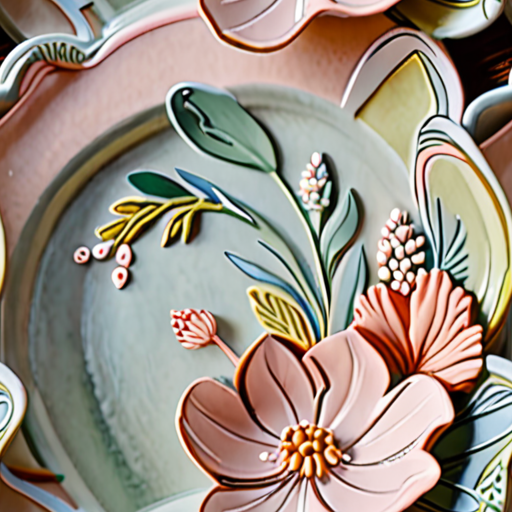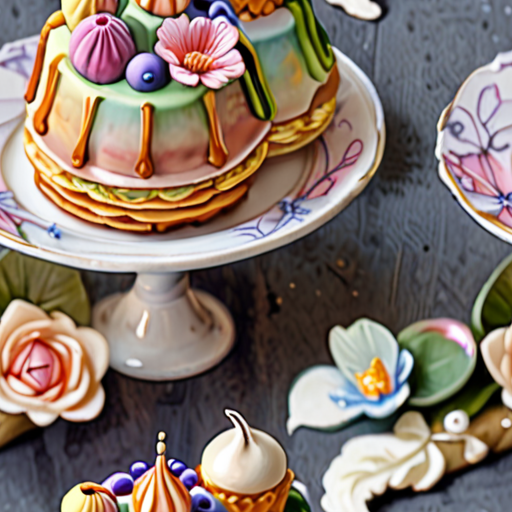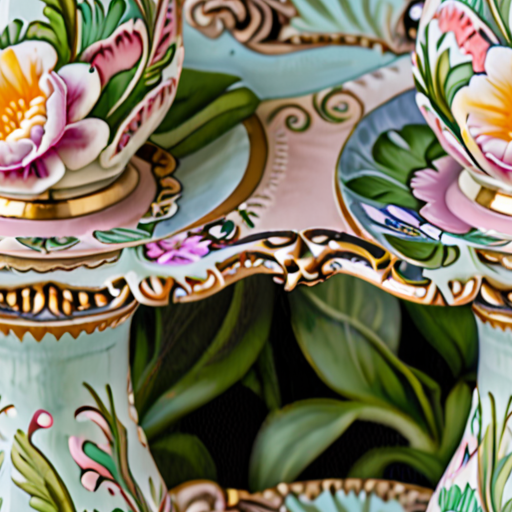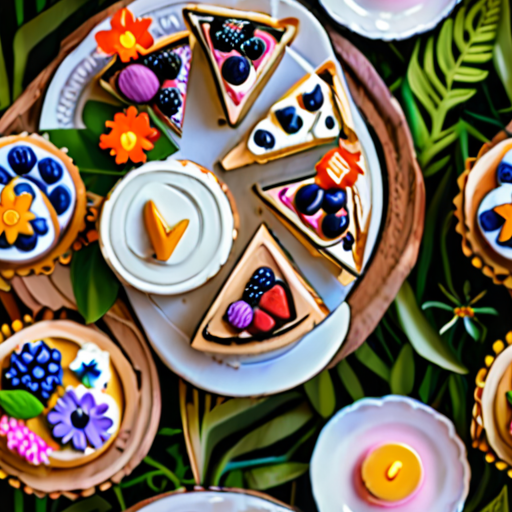When it comes to creating a memorable dining experience, presentation plays a crucial role in elevating your desserts from ordinary to extraordinary. One of the most effective ways to achieve this is through the art of dessert plating, which involves carefully arranging ingredients on a plate to create a visually appealing and harmonious composition. By mastering the basics of dessert plating, you can take your desserts to the next level and impress even the most discerning palates.

The Art of Proper Plating of Dessert
Dessert plating is an essential aspect of presenting sweet treats in a visually appealing manner.
- Balance Variety and Contrast with Texture: Combine textures like chewy, crunchy, creamy, crispy, and cold to create harmony on the palate.
- Garnish Appropriately: Add pops of color or exciting elements to enhance the presentation, such as fresh fruit or edible flowers.
- Create Visual Interest: Use height, shape, and size to create visual interest and draw attention to the dessert.
- Consider the Color Scheme: Choose colors that complement the dessert and create a cohesive look.
- Add a Personal Touch: Incorporate personal touches, such as a handwritten note or a small decorative element, to make the dessert feel special.
Tips for Creating a Beautiful Dessert Presentation
- Start with a Clean Slate: Make sure the plate is clean and free of any debris before adding the dessert.
- Choose the Right Plate: Select a plate that complements the dessert and adds to its visual appeal.
- Add a Garnish: Add a garnish, such as fresh fruit or edible flowers, to add color and texture to the dessert.
- Create Height: Use pedestals, risers, or other creative solutions to add height and visual interest to the dessert.
- Pay Attention to Proportion: Make sure the dessert is proportional to the plate and other elements on the table.
Common Mistakes to Avoid
Avoid common mistakes, such as:
- Over-accessorizing: Too many garnishes or decorations can overwhelm the dessert and detract from its beauty.
- Under-plating: Not enough garnishes or decorations can make the dessert look bare and unappetizing.
- Inconsistent Color Scheme: Choosing colors that clash or don’t complement the dessert can create a visually unappealing presentation.
Best Practices for Plating Desserts
Follow these best practices to create stunning desserts:
- Keep it Simple: Don’t over-accessorize or over-garnish the dessert.
- Balance Textures: Combine different textures to create a harmonious presentation.
- Consider the Theme: Choose a theme or color scheme that complements the occasion and the dessert.
- Have Fun: Experiment with different garnishes, decorations, and presentation styles to find what works best for you.
The Art of Dessert Plating
Dessert plating refers to the creative process of arranging and presenting individual components of a dessert in a visually appealing manner.
- Components of a Plated Dessert
- Sauce or syrup
- Fruit or garnish
- Cream or mousse
- Cake or pastry
- Key Principles of Dessert Plating
- Balance: Balance flavors, textures, and colors to create harmony
- Contrast: Use contrasting colors, shapes, and sizes to create visual interest
- Emphasis: Highlight the star component of the dessert
- Storytelling: Tell a story through the presentation of the dessert
- Tips for Effective Dessert Plating
- Keep it simple: Don’t over-accessorize the plate
- Consider the color palette: Choose colors that complement the dessert
- Play with texture: Mix smooth and rough textures for added interest
- Pay attention to portion control: Make sure the portions are balanced and proportional
- Benefits of Creative Dessert Plating
- Increased customer satisfaction: Visually appealing desserts can elevate the dining experience
- Increased sales: Creative desserts can attract customers and increase sales
- Brand differentiation: Unique dessert presentations can set a restaurant apart from others
- Best Practices for Dessert Plating
- Practice makes perfect: Experiment with different arrangements and techniques
- Stay inspired: Follow food bloggers, chefs, and restaurants for inspiration
- Invest in quality equipment: Invest in high-quality plates, utensils, and garnishes
- Train staff: Educate staff on the importance of dessert plating and how to execute it effectively

Dessert Plating Components
The art of dessert plating involves carefully arranging various components to create a visually appealing presentation.
- Main Item:
- Sauces:
- Crunch Component:
- Garnish:
The main item is the central element of the dessert plating, often the star of the show. It can be a cake, tart, or other sweet treat that serves as the focal point of the arrangement.
Sauces play a crucial role in adding flavor and moisture to the dessert. They can be drizzled, poured, or spooned onto the main item, adding a pop of color and visual interest.
A crunchy element adds texture and contrast to the smoothness of the main item and sauces. This can be achieved with nuts, cookies, or other crunchy ingredients.
A garnish adds a finishing touch to the dessert plating, often serving as a decorative element. Fresh fruits, edible flowers, or microgreens can be used to add a burst of color and freshness.
By combining these four components, dessert platers can create visually stunning presentations that delight the senses and leave a lasting impression.

Designing a Dessert Plate
At Memories Restaurant, we believe that presentation is just as important as the taste of our desserts.
- Create a visually appealing arrangement by balancing colors, textures, and heights.
- Consider the occasion and theme of the event when selecting the dessert and its presentation.
- Keep the overall look simple yet elegant, avoiding clutter and excessive decorations.
- Pay attention to the color palette and choose a dominant color scheme that complements the dessert.
- Don’t forget to leave space between each element to create a clean and harmonious composition.
Main Component Placement
The main component of the dessert doesn’t have to be centered, but rather placed slightly off-center to create visual interest.
- Place the main component in a prominent position, taking into account the size and shape of the dessert.
- Radiate sauces, ice creams, or sorbets from the main component without too much separation.
- Add garnishes around the main component to create a balanced and harmonious arrangement.
- Experiment with different placement options to find the most visually appealing composition.
Garnish Selection
Select garnishes that complement the flavors and colors of the dessert, adding texture and visual appeal.
- Fresh fruits, nuts, and edible flowers are popular garnish options that add natural beauty to the dessert.
- Chocolate shavings, caramel drizzle, or sprinkles can add a pop of color and whimsy to the arrangement.
- Choose garnishes that fit the theme and occasion of the event, such as seasonal fruits or festive sprinkles.
- Avoid over-accessorizing the dessert, allowing the main component to remain the focal point.
Sauce and Topping Placement
Position sauces and toppings strategically to balance the composition and add visual interest.
- Drizzle sauces in a zig-zag pattern or in small pools around the main component.
- Add toppings such as whipped cream, chopped nuts, or shaved chocolate in a random or deliberate pattern.
- Experiment with different sauce and topping combinations to find the perfect balance.
- Remember to leave space between each element to prevent overcrowding the dessert plate.
Final Touches
Add a personal touch to the dessert plate by incorporating personal preferences and creative flair.
- Use a decorative plate or charger to elevate the presentation and add a touch of elegance.
- Add a sprinkle of edible glitter or a few fresh herbs to give the dessert a unique and personalized touch.
- Consider the serving utensils and napkins to complete the overall look and feel of the dessert plate.
- Have fun and get creative with the presentation – it’s a great opportunity to express your personality!
Optimal Size for Dessert Plates
Dessert plates come in various sizes, but what is considered standard?
- The ideal size for a dessert plate is between 8 to 10 inches in diameter.
- This size allows for a generous serving of dessert without overwhelming the plate.
- For larger desserts, consider using a smaller plate to balance the portion size.
- Conversely, for smaller desserts, a slightly larger plate can provide a more visually appealing presentation.
When selecting a dessert plate, consider the type of dessert being served and the overall aesthetic you want to achieve.
At Memories Restaurant, we offer a variety of dessert plates to suit your needs, from classic white porcelain to elegant glassware.
Our team of experienced chefs and designers work together to create unique and delicious desserts that are sure to impress.
Contact us today to learn more about our dessert options and to reserve a table at our restaurant.

Layout a Dessert Table
To create a visually appealing dessert table, start by deciding on a centerpiece, such as a simple layer cake set up high on a ruffled tiered cake stand.
- Create balance with serving dishes and your desserts.
- Select a variety of sweet treats, including cupcakes, macarons, and chocolates.
- Consider adding decorative elements, such as fresh flowers, greenery, or candles, to add color and texture to the table.
- Don’t forget to leave space between each item to prevent overcrowding and allow guests to easily access the desserts.
Symmetry vs. Asymmetry
A symmetrical dessert table can be striking and easy to style, but it may lack visual interest. An asymmetrical table, on the other hand, can add a touch of whimsy and personality to the event.
- Start by placing a statement piece, such as a large cake or a show-stopping dessert display, in the center of the table.
- Add smaller items around the perimeter of the table, varying the height and texture to create visual interest.
- Consider adding a few unexpected elements, such as a vintage tea set or a unique vase, to add personality to the table.
Tips for Creating a Beautiful Dessert Table
Here are a few additional tips for creating a beautiful dessert table:
- Choose a variety of colors and textures to add visual interest to the table.
- Consider adding a few personal touches, such as photos or mementos, to make the table feel more special.
- Make sure to have plenty of serving utensils and plates on hand to make it easy for guests to serve themselves.
- Finally, don’t forget to have fun and be creative!
Conclusion
With these tips and ideas, you’ll be well on your way to creating a stunning dessert table that will impress your guests and leave a lasting impression. Remember to have fun and be creative, and don’t be afraid to experiment and try new things. Happy decorating!

0 Comments